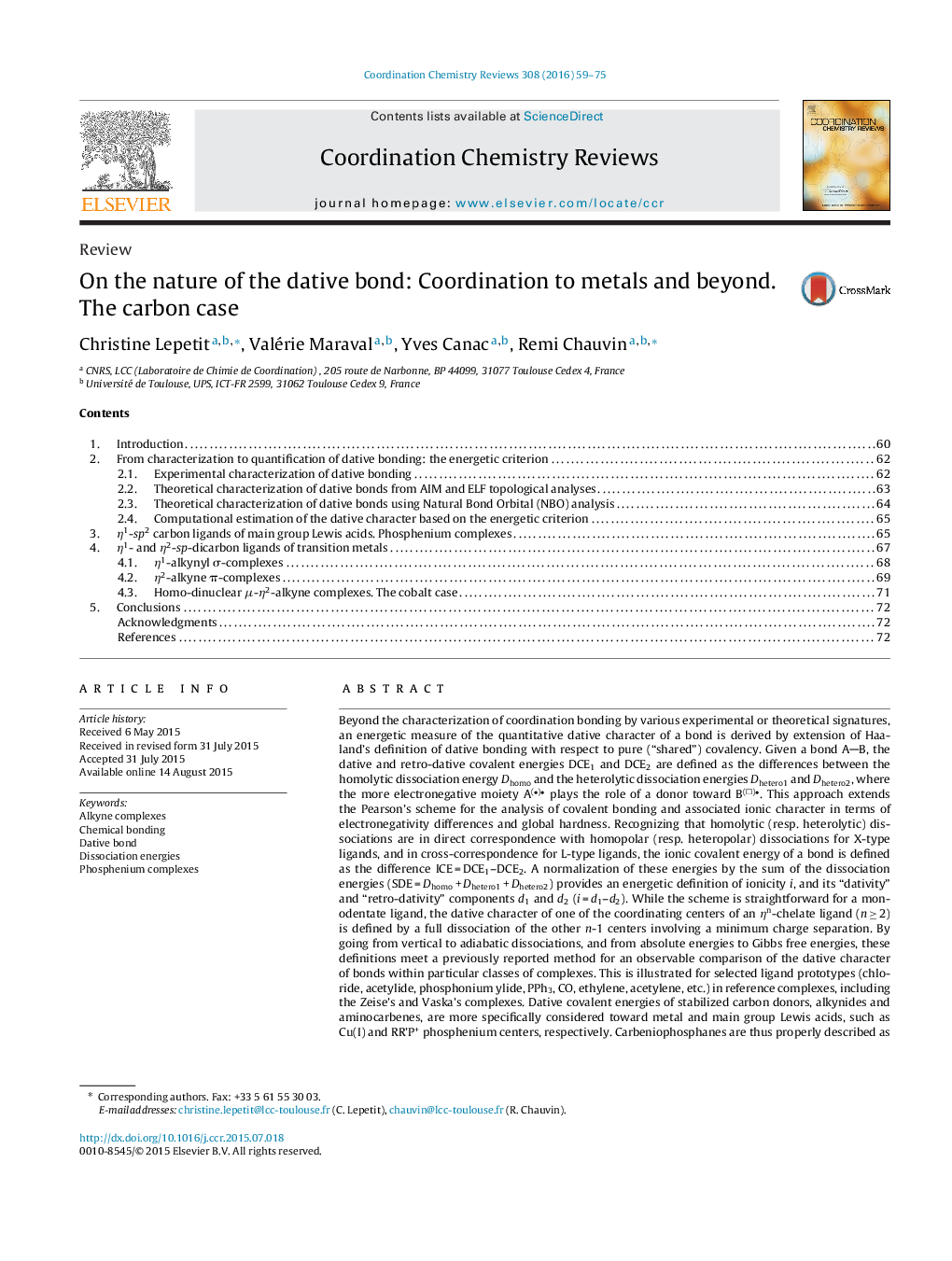| کد مقاله | کد نشریه | سال انتشار | مقاله انگلیسی | نسخه تمام متن |
|---|---|---|---|---|
| 1300847 | 974455 | 2016 | 17 صفحه PDF | دانلود رایگان |
• Achievements in theoretical analysis of the fundamental nature of the dative bond.
• Definition of “dative covalence energies” measuring the dative character of a bond.
• Computational illustrations of the definition on scholar examples of compounds.
• Focus on ligands centered on the cabon element: carbenes, ylides, acetylides, and alkynes.
• Focus on complexes of the following metals: Fe, Co, Ni, Cu, Pd, Rh, Ir, Pt, etc.
Beyond the characterization of coordination bonding by various experimental or theoretical signatures, an energetic measure of the quantitative dative character of a bond is derived by extension of Haaland's definition of dative bonding with respect to pure (“shared”) covalency. Given a bond AB, the dative and retro-dative covalent energies DCE1 and DCE2 are defined as the differences between the homolytic dissociation energy Dhomo and the heterolytic dissociation energies Dhetero1 and Dhetero2, where the more electronegative moiety A(
• )
• plays the role of a donor toward B(□)
• . This approach extends the Pearson's scheme for the analysis of covalent bonding and associated ionic character in terms of electronegativity differences and global hardness. Recognizing that homolytic (resp. heterolytic) dissociations are in direct correspondence with homopolar (resp. heteropolar) dissociations for X-type ligands, and in cross-correspondence for L-type ligands, the ionic covalent energy of a bond is defined as the difference ICE = DCE1–DCE2. A normalization of these energies by the sum of the dissociation energies (SDE = Dhomo + Dhetero1 + Dhetero2) provides an energetic definition of ionicity i, and its “dativity” and “retro-dativity” components d1 and d2 (i = d1–d2). While the scheme is straightforward for a monodentate ligand, the dative character of one of the coordinating centers of an ηn-chelate ligand (n ≥ 2) is defined by a full dissociation of the other n-1 centers involving a minimum charge separation. By going from vertical to adiabatic dissociations, and from absolute energies to Gibbs free energies, these definitions meet a previously reported method for an observable comparison of the dative character of bonds within particular classes of complexes. This is illustrated for selected ligand prototypes (chloride, acetylide, phosphonium ylide, PPh3, CO, ethylene, acetylene, etc.) in reference complexes, including the Zeise's and Vaska's complexes. Dative covalent energies of stabilized carbon donors, alkynides and aminocarbenes, are more specifically considered toward metal and main group Lewis acids, such as Cu(I) and RR’P+ phosphenium centers, respectively. Carbeniophosphanes are thus properly described as carbene−phosphenium adducts (DCE1 > 0), while a bisaminocyclopropylidene (BAC) draws nearer to the boarderline case DCE1 ∼ 0. The η1 and η2 coordination features of acetylenic ligands in mono- or bi-metallic complexes are then surveyed, in particular in Co2(CO)6 complexes. The formal treatment of η3 coordination of propargyl ligands is finally addressed in the case of Nicholas’ complexes.
Journal: Coordination Chemistry Reviews - Volume 308, Part 2, 1 February 2016, Pages 59–75
